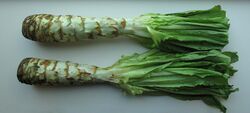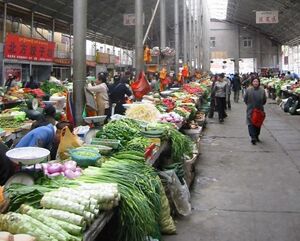Biology:Celtuce
| Celtuce | |
|---|---|
 Celtuce stems & heads | |
| Species | Lactuca sativa var. augustana |
| Cultivar | 'Celtuce' |
| Origin | Mediterranean region |
Celtuce (/ˈsɛlt.əs/) (Lactuca sativa var. augustana,[1][2][3] angustata, or asparagina), also called stem lettuce,[4] celery lettuce, asparagus lettuce,[5] or Chinese lettuce, is a cultivar of lettuce grown primarily for its thick stem or its leaves. It is used as a vegetable and is especially popular in both mainland China and Taiwan, where the stem is interchangeably called qingsun (Chinese: 青笋; pinyin: qīngsǔn) or wosun (Chinese: 莴笋; pinyin: wōsǔn). Prepared separately, the leaves are called (Chinese: 油麦菜; pinyin: yóumàicài).
The pale green leaves,[5] which are tender,[2] and white stems,[4] can be eaten raw (in salads) or cooked. It can be pickled, grilled, roasted, or stir-fried.[4][5] It is mild but nutty, with a slight smoky aftertaste.[5][6] It is high in vitamins.[4]
It is thought to have originated in the Mediterranean region and then brought to China during Tang Dynasty,[6] about A.D. 600–900.[7]
It can be grown from seed and is sown from April through May. The seeds can be planted in a set bed or a temporary nursery bed and then transplanted to the growing site. They should be spread 30 cm apart each way. The young (edible) leaves are ready about 4–5 weeks after planting and the edible stems are ready when about 30 cm tall. They are usually harvested between July and September.[4]
The plant can suffer from aphid attack.[7]

| Nutritional value per 100 g (3.5 oz) | |
|---|---|
| Energy | 75 kJ (18 kcal) |
3.65 g | |
| Dietary fiber | 1.7 g |
0.3 g | |
0.85 g | |
| Vitamins | Quantity %DV† |
| Vitamin A equiv. | 22% 175 μg |
| Thiamine (B1) | 5% 0.055 mg |
| Riboflavin (B2) | 6% 0.07 mg |
| Niacin (B3) | 4% 0.55 mg |
| Pantothenic acid (B5) | 4% 0.183 mg |
| Vitamin B6 | 4% 0.05 mg |
| Folate (B9) | 12% 46 μg |
| Vitamin C | 23% 19.5 mg |
| Minerals | Quantity %DV† |
| Calcium | 4% 39 mg |
| Iron | 4% 0.55 mg |
| Magnesium | 8% 28 mg |
| Manganese | 33% 0.688 mg |
| Phosphorus | 6% 39 mg |
| Potassium | 7% 330 mg |
| Sodium | 1% 11 mg |
| Zinc | 3% 0.27 mg |
| |
| †Percentages are roughly approximated using US recommendations for adults. Source: USDA Nutrient Database | |
The stem is usually harvested at a length of around 15–20 cm and a diameter of around 3–4 cm. It is crisp, moist, and mildly flavored, and typically prepared by slicing and then stir frying with more strongly flavored ingredients.
See also
References
- ↑ Stanley J. Kays iCultivated Vegetables of the World: A Multilingual Onomasticon, p. 658, at Google Books
- ↑ 2.0 2.1 Masatoshi Yamaguchi World Vegetables: Principles, Production and Nutritive Values, p. 208, at Google Books
- ↑ Caroline Foley How to Plant Your Allotment, p. 51, at Google Books
- ↑ 4.0 4.1 4.2 4.3 4.4 "Celtuce or Stem Lettuce". kingsseeds.com. https://www.kingsseeds.com/Products/Vegetables/Oriental/Celtuce-or-Stem-Lettuce. Retrieved 28 January 2017.
- ↑ 5.0 5.1 5.2 5.3 Nosowitz, Dan (29 April 2016). "Meet The Vegetable: Celtuce, a Mutant and Delicious Lettuce ..on". modernfarmer.com. http://modernfarmer.com/2016/04/celtuce/. Retrieved 28 January 2017.
- ↑ 6.0 6.1 "Celtuce ribbon salad". soyricefire.com. 21 April 2013. http://soyricefire.com/2013/04/21/celtuce-ribbon-salad/. Retrieved 28 January 2017.
- ↑ 7.0 7.1 "Celtuce, 'Wo Sun'". seedaholic.com. http://www.seedaholic.com/celtuce-wo-sun.html. Retrieved 28 January 2017.
Wikidata ☰ Q574172 entry

